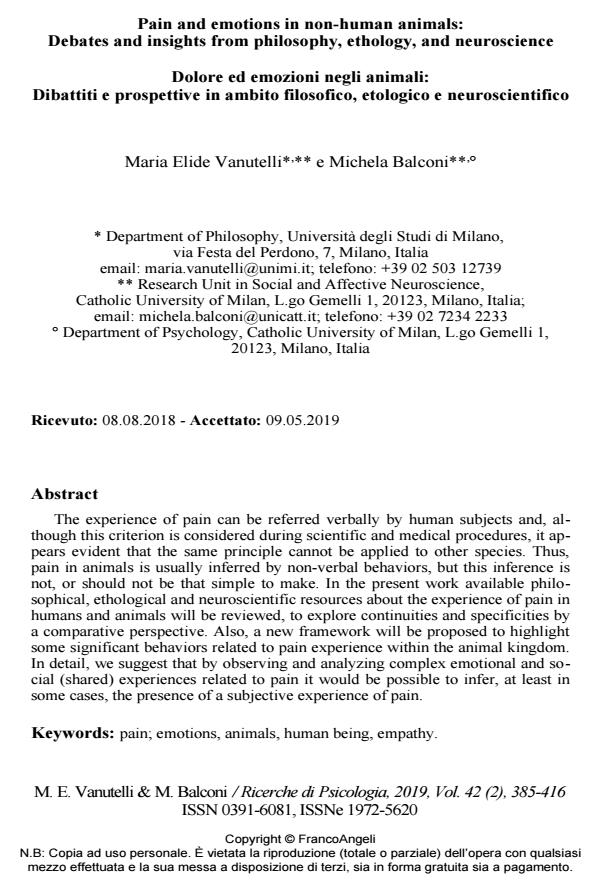Pain and emotions in non-human animals: Debates and insights from philosophy, ethology, and neuroscience
Titolo Rivista RICERCHE DI PSICOLOGIA
Autori/Curatori Maria Elide Vanutelli, Michela Balconi
Anno di pubblicazione 2019 Fascicolo 2019/2
Lingua Inglese Numero pagine 32 P. 385-416 Dimensione file 279 KB
DOI 10.3280/RIP2019-002008
Il DOI è il codice a barre della proprietà intellettuale: per saperne di più
clicca qui
Qui sotto puoi vedere in anteprima la prima pagina di questo articolo.
Se questo articolo ti interessa, lo puoi acquistare (e scaricare in formato pdf) seguendo le facili indicazioni per acquistare il download credit. Acquista Download Credits per scaricare questo Articolo in formato PDF

FrancoAngeli è membro della Publishers International Linking Association, Inc (PILA)associazione indipendente e non profit per facilitare (attraverso i servizi tecnologici implementati da CrossRef.org) l’accesso degli studiosi ai contenuti digitali nelle pubblicazioni professionali e scientifiche
The experience of pain can be referred verbally by human subjects and, although this criterion is considered during scientific and medical procedures, it appears evident that the same principle cannot be applied to other species. Thus, pain in animals is usually inferred by non-verbal behaviors, but this inference is not, or should not be that simple to make. In the present work available philosophical, ethological and neuroscientific resources about the experience of pain in humans and animals will be reviewed, to explore continuities and specificities by a comparative perspective. Also, a new framework will be proposed to highlight some significant behaviors related to pain experience within the animal kingdom. In detail, we suggest that by observing and analyzing complex emotional and social (shared) experiences related to pain it would be possible to infer, at least in some cases, the presence of a subjective experience of pain.
I criteri standard per valutare la presenza di esperienze legate al dolore prevedono un riscontro verbale da parte dei soggetti (umani) coinvolti. Tuttavia, mentre questo tipo di informazioni vengono normalmente considerate durante procedure mediche e scientifiche, appare evidente che lo stesso tipo di indagine non può essere effettuata nel caso degli animali non umani. A questo proposito sono stati sviluppati alcuni metodi per dedurre la presenza di dolore tramite la valutazione di indizi non verbali, anche se simili inferenze non sono, o quantomeno non dovrebbero essere, così facili da fare. Lo scopo del presente studio è quello di raccogliere le principali evidenze filosofiche, etologiche e neuroscientifiche sull’esperienza del dolore nell’uomo e negli animali, per esplorare la presenza di continuità e specificità da una prospettiva comparativa. Inoltre, verrà proposta una nuova cornice interpretativa che possa aiutare a cogliere alcuni comportamenti significativi legati all’esperienza del dolore nel regno animale. Più specificamente, proponiamo l’osservazione e l’analisi di esperienze emotive e sociali complesse (e condivise) come strumento per dedurre, almeno in alcuni casi, la presenza di un’esperienza soggettiva di dolore.
Parole chiave:Dolore, emozioni, animali, esseri umani, empatia.
Maria Elide Vanutelli, Michela Balconi, Pain and emotions in non-human animals: Debates and insights from philosophy, ethology, and neuroscience in "RICERCHE DI PSICOLOGIA " 2/2019, pp 385-416, DOI: 10.3280/RIP2019-002008